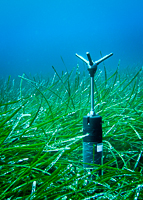ABSTRACT
We demonstrate the utility of using the equivalent bottom roughness for calculating the friction factor and the drag coefficient of a seagrass meadow for conditions in which the meadow height is small compared to the water depth. Wave attenuation induced by the seagrass Posidonia oceanica is evaluated using field data from bottom-mounted acoustic doppler velocimeters (ADVs).
Using the data from one storm event, the equivalent bottom roughness is calculated for the meadow as ks ~ 0.40 m. This equivalent roughness is used to predict the wave friction factor ƒw, the drag coefficient on the plant, CD, and ultimately the wave attenuation for other storms. Root mean squared wave height (Hrms) is reduced by around 50% for incident waves of 1.1 m propagating over ~1000 m of a meadow of P. oceanica with shoot density of ~600 shoots m−2.











[…] We use mainly the Vector ADV (Nortek) whic is very robust oceanographic instruments which provide very reliable data measurements. They measure flow velocity in a single small cell and also measures pressure. The range of scientific possibilities with ADVs are huge since its possible to measure turbulence due to the high speed sampling. The cost of the instrument is also huge, between 12,000-15,000 Eur. The battery packs are rechargeable and can be easily replaced by opening the instrument. The instruments can be deployed in looking up, down, or sideways. It is very important that the instrument is very stable since oscillations could affect the data quality. See deployment set ups in Infantes et al. (2011) and Infantes et al. (2012) […]